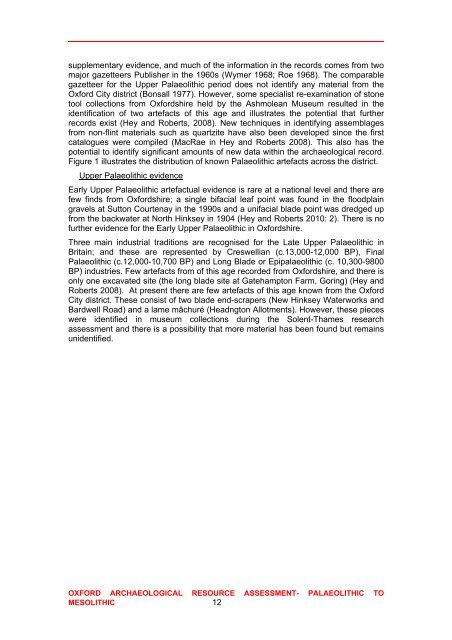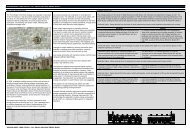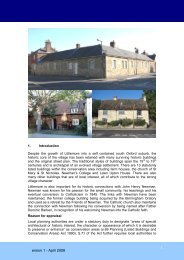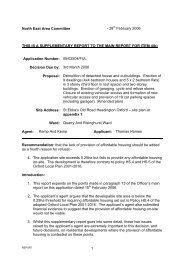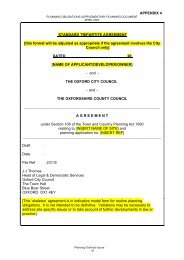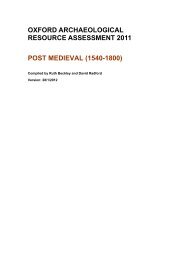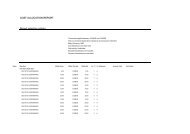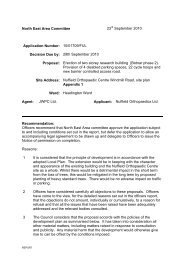Palaeolithic to Mesolithic Oxford (500000 - 4000 BC) - Oxford City ...
Palaeolithic to Mesolithic Oxford (500000 - 4000 BC) - Oxford City ...
Palaeolithic to Mesolithic Oxford (500000 - 4000 BC) - Oxford City ...
Create successful ePaper yourself
Turn your PDF publications into a flip-book with our unique Google optimized e-Paper software.
supplementary evidence, and much of the information in the records comes from two<br />
major gazetteers Publisher in the 1960s (Wymer 1968; Roe 1968). The comparable<br />
gazetteer for the Upper <strong>Palaeolithic</strong> period does not identify any material from the<br />
<strong>Oxford</strong> <strong>City</strong> district (Bonsall 1977). However, some specialist re-examination of s<strong>to</strong>ne<br />
<strong>to</strong>ol collections from <strong>Oxford</strong>shire held by the Ashmolean Museum resulted in the<br />
identification of two artefacts of this age and illustrates the potential that further<br />
records exist (Hey and Roberts, 2008). New techniques in identifying assemblages<br />
from non-flint materials such as quartzite have also been developed since the first<br />
catalogues were compiled (MacRae in Hey and Roberts 2008). This also has the<br />
potential <strong>to</strong> identify significant amounts of new data within the archaeological record.<br />
Figure 1 illustrates the distribution of known <strong>Palaeolithic</strong> artefacts across the district.<br />
Upper <strong>Palaeolithic</strong> evidence<br />
Early Upper <strong>Palaeolithic</strong> artefactual evidence is rare at a national level and there are<br />
few finds from <strong>Oxford</strong>shire; a single bifacial leaf point was found in the floodplain<br />
gravels at Sut<strong>to</strong>n Courtenay in the 1990s and a unifacial blade point was dredged up<br />
from the backwater at North Hinksey in 1904 (Hey and Roberts 2010: 2). There is no<br />
further evidence for the Early Upper <strong>Palaeolithic</strong> in <strong>Oxford</strong>shire.<br />
Three main industrial traditions are recognised for the Late Upper <strong>Palaeolithic</strong> in<br />
Britain; and these are represented by Creswellian (c.13,000-12,000 BP), Final<br />
<strong>Palaeolithic</strong> (c.12,000-10,700 BP) and Long Blade or Epipalaeolithic (c. 10,300-9800<br />
BP) industries. Few artefacts from of this age recorded from <strong>Oxford</strong>shire, and there is<br />
only one excavated site (the long blade site at Gatehamp<strong>to</strong>n Farm, Goring) (Hey and<br />
Roberts 2008). At present there are few artefacts of this age known from the <strong>Oxford</strong><br />
<strong>City</strong> district. These consist of two blade end-scrapers (New Hinksey Waterworks and<br />
Bardwell Road) and a lame mâchuré (Headng<strong>to</strong>n Allotments). However, these pieces<br />
were identified in museum collections during the Solent-Thames research<br />
assessment and there is a possibility that more material has been found but remains<br />
unidentified.<br />
OXFORD ARCHAEOLOGICAL RESOURCE ASSESSMENT- PALAEOLITHIC TO<br />
MESOLITHIC 12


